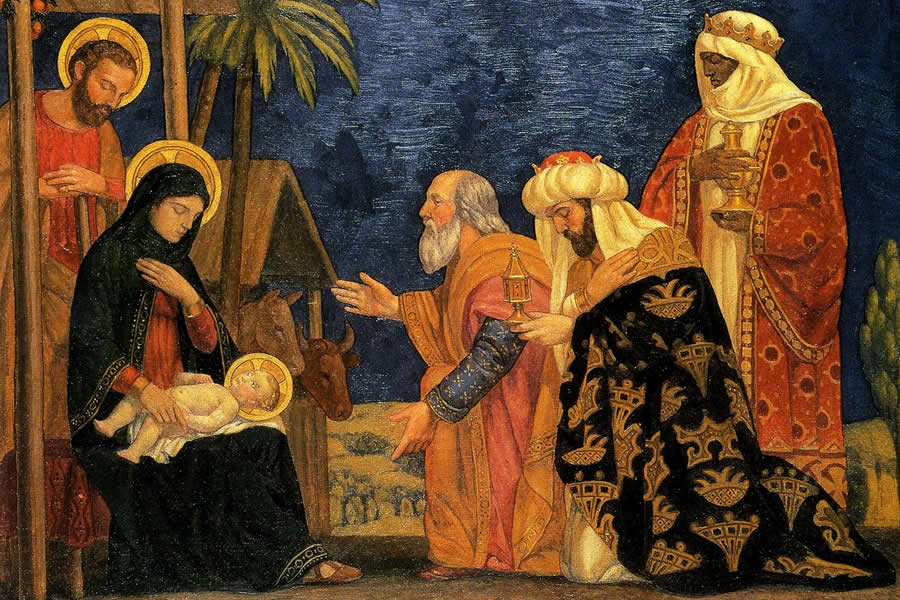Parish Blog

We Have Seen His Star
01-02-2022Pastor's LetterRev. Gregory B. WilsonDear Brothers and Sisters in Christ,
This year, we arrive a little early to the Epiphany of the Lord, a.k.a., Three Kings Day. Traditionally celebrated on the Twelfth Day of Christmas (Jan. 6), liturgically in the United States and some other countries, it is moved to its closest Sunday after Jan. 1.
The word “epiphany” comes from a Greek word that means “manifestation,” i.e., making something known. From the Catechism:
“The Epiphany is the manifestation of Jesus as Messiah of Israel, Son of God and Savior of the world. The great feast of Epiphany celebrates the adoration of Jesus by the wise men (magi) from the East, together with His baptism in the Jordan and the wedding feast at Cana in Galilee. “In the magi, representatives of the neighboring pagan religions, the Gospel sees the first-fruits of the nations, who welcome the good news of salvation through the Incarnation.” (CCC 528)
Why is it celebrated twelve days after the celebration of Christ’s birth?
“It is hard to say how far back the beginnings of the Christmas feast go. It assumed its definitive form in the third century [i.e., the 200s A.D.]. At about the same time the feast of the Epiphany emerged in the East on January 6 and the feast of Christmas in the West on December 25. The two feasts had different emphases because of the different religious and cultural contexts in which they arose, but essentially their meaning was the same: the celebration of the birth of Christ as the dawning of the new light, the true sun, of history” (The Spirit of the Liturgy, Joseph Ratzinger, pp. 106-107).
Eventually, the emphasis on the January 6 feast shifted to three manifestations of Christ’s divinity to the world: 1) the visit of the Magi (Matthew 2:1-12); 2) the first miracle at the wedding feast at Cana where Jesus “revealed His glory, and His disciples began to believe in Him” (John 2:1-12); and 3) the Baptism of Jesus in the Jordan, when the Holy Trinity became manifest with the Holy Spirit (the dove) and the voice of the Father, “This is my beloved Son, with whom I am well pleased” (Matthew 3:13-17; Mark 1:9-11; and Luke 3:21-22).
Shifting to local news: Due to bulletin deadlines around the holidays, this article has to be prepared a little over two weeks ahead. However, upon writing this, progress on the roof of Old St. Mary’s was going extremely well and on schedule. When work is complete, we will move all daily Masses back to Old St. Mary’s. The restoration and refurbishment of the organ in the historic church will begin soon, and will take about a year to complete.
Merry Christmas, and a blessed Epiphany!
Father Wilson
Queridos hermanos en Cristo:
Este año, llegamos un poco temprano a la Epifanía del Señor, también conocido como el Día de los Reyes Magos. Celebrado tradicionalmente el duodécimo día de Navidad (6 de enero), litúrgicamente en los Estados Unidos y en algunos otros países, se traslada a su domingo más cercano después del 1 de enero.
La palabra "epifanía" proviene de una palabra griega que significa "manifestación", es decir, dar a conocer algo. Del Catecismo:
“La Epifanía es la manifestación de Jesús como Mesías de Israel, Hijo de Dios y Salvador del mundo. La gran fiesta de la Epifanía celebra la adoración de Jesús por los sabios (magos) de Oriente, junto con su bautismo en el Jordán y las bodas de Caná de Galilea.
"En los magos, representantes de las religiones paganas vecinas, el Evangelio ve las primicias de las naciones, que acogen la buena noticia de la salvación a través de la Encarnación". (CCC 528)
¿Por qué se celebra doce días después de la celebración del nacimiento de Cristo?
“Es difícil decir cuán atrás se remontan los inicios de la fiesta de Navidad. Asumió su forma definitiva en el siglo III [es decir, el 200 d.C.]. Aproximadamente al mismo tiempo, la fiesta de la Epifanía surgió en Oriente el 6 de enero y la fiesta de Navidad en Occidente el 25 de diciembre. Las dos fiestas tenían diferentes énfasis debido a los diferentes contextos religiosos y culturales en los que surgieron, pero esencialmente su significado era el mismo: la celebración del nacimiento de Cristo como el amanecer de la nueva luz, el verdadero sol, de la historia” (El espíritu de la liturgia, Joseph Ratzinger, págs. 106-107).
Finalmente, el énfasis en la fiesta del 6 de enero se trasladó a tres manifestaciones de la divinidad de Cristo al mundo: 1) la visita de los Magos (Mateo 2: 1-12); 2) el primer milagro en las bodas de Caná, donde Jesús “reveló su gloria y sus discípulos empezaron a creer en él” (Juan 2: 1- 12); y 3) el bautismo de Jesús en el Jordán, cuando la Santísima Trinidad se manifestó con el Espíritu Santo (la paloma) y la voz del Padre: “Este es mi Hijo amado, en quien tengo complacencia” (Mateo 3: 13-17; Marcos 1: 9-11; y Lucas 3: 21-22).
Pasando a las noticias locales: debido a las fechas límite de los boletines alrededor de las vacaciones, este artículo debe prepararse con un poco más de dos semanas de anticipación. Sin embargo, al escribir esto, el progreso en el techo de Santa María Histórica va extremadamente bien y según lo programado. Cuando se complete el trabajo, trasladaremos todas las misas diarias a Santa María Histórica. La restauración y remodelación del órgano en la iglesia histórica comenzará pronto y tardará aproximadamente un año en completarse.
¡Feliz Navidad y bendita Epifanía!
Padre Wilson
BACK TO LIST